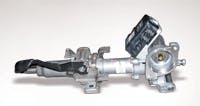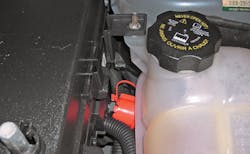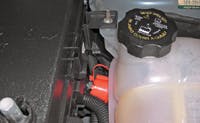Editor's Note: This article has been updated from its original 2011 version.
GM vehicles have used electric power steering (EPS) systems for over a decade now, so odds are good you've already worked on a vehicle using the system. Interestingly, it's not just expensive or luxury models that use EPS. Because the system is such a fuel-saver and also lowers emissions, it's turned up on most of the vehicles on the road. And that means that you need to know how the system works, what goes wrong and how to fix it – quickly, safely and profitably.
The idea behind EPS is the same as the idea behind hydraulically assisted power steering systems: reducing the amount of effort needed to turn the steering wheel. EPS simply uses an electric motor to provide the assist rather than use a hydraulic pressure system. The EPS system is more efficient than hydraulic systems since it only needs to provide assist when the driver is actually steering (rather than robbing energy from the vehicle's engine to rotate the hydraulic pump constantly), and it keeps the environmentalists happy since there's no harmful fluid involved that needs to be flushed or drained.
EPS is a relatively simple system
The steering shaft torque sensor (located in a section of torsion bar in between the steering input and output shafts) is the Power Steering Control Module's (PSCM) main input for determining steering direction and the amount of assist needed. Getting extremely technical, the torque signals are determined by the relative position between the upper and lower rotors of the sensor. This sensor is a five-volt, dual analog inverse signal device; operating between 0.25V and 4.75V (as many five-volt reference sensors do – voltage outside of this range usually indicates a circuit problem and sets a DTC).
It sounds complicated, but it really isn't.
Turning the steering wheel to the right increases Signal 1 Voltage and decreases Signal 2 Voltage. Turning to the left decreases Signal 1 Voltage and increases Signal 2 Voltage. The PSCM interprets the change in signal voltages as "steering direction" and steering column shaft "applied torque." Simple, really.
The steering wheel position sensor is a five-volt, dual analog signal device, but this one operates between 0V to 5V. The Signal 1 and Signal 2 voltages increase and decrease, staying within 2.5 to 2.8 volts of each other as the steering wheel is turned.
One thing to be aware of is that the PSCM uses the Steering Wheel Position Sensor to "locate" the on-center position and will actually provide a small amount of electrical current to "return" to the center position (not beyond the center position though).
The steering motor itself is typically a DC, reversible motor that provides assist through a worm gear and reduction gear. The PSCM combines inputs such as steering shaft torque sensor, vehicle speed (via serial data), calculated system temperature, and steering tuning setting to determine the amount of assist required — for example, greater assist would be provided at slow-speed parking than during a high-speed lane change — and commands the correct amount of current (or assist) to the power steering motor.
One important thing to note: Because the motor isn't designed to handle extremely high power for extended periods of time (for example, turning from lock to lock repeatedly while the vehicle is stationary), the EPS system will protect itself by limiting the amount of current commanded to reduce system temperature — and unfortunately, limiting assist in the process.
Fixing what goes wrong
As always, a good scan tool, service information, TSBs and calibration updates all are important for successfully repairing the vehicle. But there are a few tips that really can help speed up the diagnostic process. Problems in the EPS system usually come down to one of three things: mechanical problems, electrical problems, or sneaky problems that fool you into thinking they're steering-related when they're actually caused by another system or component. And it's relatively simple to figure out which of the three is causing the problem.
Mechanical
Mechanical EPS problems show up as noises, vibration or other physical steering system faults. They range from mildly annoying to downright scary so it's important to locate the cause of the problem quickly.
If the problem is a mechanical one, the diagnostic process is very similar to that of a hydraulic system. In this case, you'd separate the assist portion of the system from the actual mechanical components and see if the problem changes or goes away. This is done by removing the electric assist form the steering components and see if the noise disappears or changes.
Turning slowly (10 mph) and wide in a gravel parking lot then releasing the steering wheel while turning loads and then unloads the steering components (steering column, intermediate shaft and steering gear) without requiring assist from the steering motor, making noises form those components easier to find.
Alternatively, removing the 60 amp EPS fuse in the underhood fuse block also removes the assist from the mechanical components. If the problem is present when the assist is disabled, the concern is likely a mechanical one.
If the problem is indeed in the steering column assembly and the module, motor, or module and motor are replaced, a scan tool will be needed to calibrate the sensors and set the system up properly.
Also note that the steering wheel position sensor and torque sensor calibration procedures should be performed after an alignment. Complaints such as poor or uneven center "feel" or return to center can also be corrected by performing these procedures.
One final note about mechanical problems. From experience, it seems that most mechanical problems with EPS systems result from the customer hitting a curb and breaking something in the column. Unfortunately, this problem is usually discovered after an alignment, when the technician turns a corner and the steering wheel jerks abruptly to one side. One technician who drove a car with this problem said it felt like the steering wheel was ripped out of his hands after the first turn – and he's glad he didn't have his hand through the actual steering wheel because it would have hurt! It's a good idea to be careful when road testing a vehicle with EPS if you suspect this might be the case.
Electrical
Electrical problems on EPS vehicles show up not only as DTCs and warning messages but can also cause the steering to be hard to turn or not work at all (such as if the steering column has overheated, thanks to excessive lock-to-lock turns – this does set a DTC though).
For electrical EPS problems (as with any electrical problems) it's best to start with the basics and go from there. Often the problem is something simple, and it's much easier to figure that out sooner rather than later. But even when you're checking the basics, using a bit of strategy rather than just looking at ground bolts, wiggling harnesses can help locate poor connections and/or electrical shorts-to-ground, making diagnosis easier and more effective.
The most basic check of all is battery voltage. If there's not enough voltage going to the system, there's no way to provide enough steering assist and/or allow the PSCM to function. Check the Battery Voltage Signal on the scan tool as well as checking the actual available voltage and ground supply at the PSCM. Of course, the vehicle's 12V battery itself should be evaluated, preliminarily.
And along those lines, include the 60-amp EPS fuse in a preliminary diagnostic check, especially if the vehicle was towed in and especially if there aren't any DTCs stored. On certain vehicles this fuse can blow if the vehicle's battery boosted incorrectly (like during a jumpstart).
Most electrical EPS problems, however, will set and store codes (DTCs) so it's a good idea to check for DTCs (current and history) early in the diagnosis. If there are DTCs stored, check the connections carefully, especially between the EPS motor and the PSCM, ensuring that the connector isn't just soft-set, but connected and actually mated properly. And as with any electrical problem, check for connector pin drag, especially if the connectors have been disconnected a few times.
Connections and wiring are a particularly good place to check if any communication history codes (U-codes) are stored. U-codes can be tricky to diagnose since they may be the result of communication problems from other modules, rather than in the module storing the code. TSBs can be a real help for U-codes. TSB 07-02-32-007B: Diagnostic Tips for Power Steering Inoperative/Steering Wheel Hard to Turn, Power Steering Message Displayed on DIC, DTCs C0176, C0475, C0476, C0550, U2105, U2107 Set - Aug 6, 2009 provides good diagnostic tips for diagnosing EPS-related DTCs (and it's short too!).
Also be sure to check for calibration updates for EPS problems. Sometimes the only way to fix a problem is by reprogramming the module so it's best to figure that out early.
However, if your diagnosis points to the control module, be aware that the PSCM may need to be configured properly with the powertrain data, body style, tire, and wheel size in addition to calibrating the sensors before the vehicle will operate correctly.
And one final note about electrical EPS diagnosis, if you need to disconnect the 12-volt battery, wait at least 25 seconds after shutting OFF the ignition before doing so to prevent module memory loss. This tip can actually be applied to all systems, not just the EPS. It's 25 seconds well spent!
Sneaky problems
According to TSB 04-03-08-006E: Steering and Front Suspension Noise Concerns-Clunk, Thump, Rattle, Knocking, Pop, Shudder, Vibration Nov 1, 2010, some of the systems that sound like they're originating from the steering column — but actually aren't — include:
- The jounce bumper contacting the upper spring seat (on Cobalt and HHR).
- Contaminated stabilizer shaft link ball studs.
- The PCM and TCM ratting against each other.
- The coolant surge tank not properly seated in place.
- Contact between the front stabilizer shaft and its bushings.
- The rear lower control arm contacting the body because the rubber bushing comes out of its steel sleeve – especially in areas that use road salt in the winter.
And that's just from one TSB! It's easy think that any problem with an EPS system (or any electrical system for that matter) is going to be caused by a complicated, expensive component but that's often not the case at all.
Suspension and component noises on vehicles with EPS can be located in the same way as non-EPS vehicles: bounce the vehicle's suspension system in the service bay on using a drive-on hoist, look for contact marks on the bushings (or bushing that are missing or damaged), look for worn, broken, damaged or missing parts, and look for any fresh body work or recently replaced components.
EPS might be a newer technology, but the suspension components are still the old familiar ones that cause the familiar concerns. Remembering the basics of suspension diagnosis can save diagnostic time when diagnosing the system.
Conclusion
EPS is just a different way to provide assistance when turning the steering wheel. Problems with the system are usually mechanical concerns, electrical concerns, or something else that sounds like a steering problem but actually isn't (or it's a normal EPS operating characteristic). With a bit of practice, you'll be able to recognize what's causing the problem quickly and repair the problem successfully. And since most manufacturers are using EPS systems, you'll find there are more similarities than differences among the different manufacturers which will make working on all manufacturer's EPS systems that much easier.
As new technologies go, EPS is easy to understand and service. Hopefully the next technology changes will be just as easy to adapt to!
Vanessa Attwell is a Master Technician for two major manufacturers and has also worked on the bench of an independent shop. She has developed and delivered training for both vehicle manufacturers and independents and helped develop government training and regulations standards.


